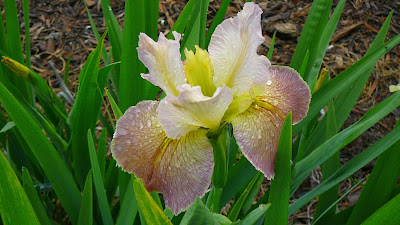by Ron Killingsworth
 |
| 'Heather Pryor' (John Taylor 1993) |
Louisiana irises got their name from the state of Louisiana, but they are grown around the world. The
Society for Louisiana Irises has members in many nations outside the United States. Louisiana iris hybridizers living "down under" in Australia have produced, registered and introduced many award-winning Louisiana irises. We are fortunate here at the AIS World of Irises to have Heather Pryor, a hybridizer of award-winning LA irises, join our team of bloggers. Be on the lookout for posts by Heather coming your way soon. In her honor, we feature the iris that carries her name, by another Australian hybridizer, John C. Taylor.
John was born in Sydney on the 4th of July. As an adult he became interested in growing irises and perhaps his birthday on the United State's independence day led to his interest in Louisiana irises.
 |
| 'Heather Pryor' |
'Heather Pryor' is one of my favorite irises. The coloring, the serrated edges, the light yellow style arms -- it just has so much beauty.
 |
| 'Heather Pryor' |
I have this iris growing in many different locations and it does well wherever I plant it. It is a great garden iris and will give great increase year after year. It produces many blooms on each stalk.
 |
| 'Heather Pryor' |
This is not the normal form of the flower but was probably freshly opened. This form (falls falling and stands standing) is one of my favorite flower forms but is not the most common form for this iris.
 |
| 'Heather Pryor' |
I would say this represents the most common form for this iris. It has creamy stands that are flushed with a pink coloring and yellow style arms.
 |
| 'Heather Pryor' |
|
The falls are registered as "cream ground, veined and heavily flushed pink toward paler rim" but I think of them as more pinkish with darker pink veining. Any way you describe it, it is a lovely iris!
Other important irises introduced by John include
'C'est Si Bon' and
'Dural White Butterfly'.
 |
| 'C'est Si Bon' (John C. Taylor 1983) |
C'est Si Bon means "it is so good," an appropriate name for this iris. It remains one of my favorite irises and the white spray pattern around the signal makes it easy to spot from a distance.
 |
| 'C'est Si Bon' |
John has registered almost 200 Louisiana irises and they have won awards in the United States as well as in Australia.
 |
| 'Dural White Butterfly' (John C. Taylor 1989) |
A number of John's irises begin with the word Dural, which is
a semi-rural suburb of Sydney, in the state of New South Wales. 'Dural White Butterfly' is one of the most outstanding white Louisiana irises and remains very popular even with today's more modern hybrids. It seems to have never won an award in the US but you will find it in many many gardens and in the genealogy of many other Louisiana irises.
.jpg) |
| 'Dural White Butterfly' |
Registered simply as "white self", this wonderful iris is certainly deserving a more vivid description! It has serrated edges and ruffling, something not common in registered irises from the 1980's.
 |
| 'Dural White Butterfly' |
The lovely green style arms and the green veined signals certainly help to make this a distinctive white Louisiana irises.










.jpg)











